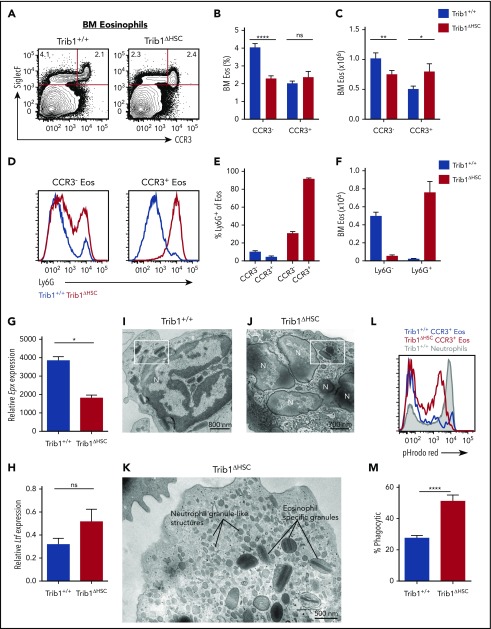Figure 2.
Ly6G+ eosinophils are expanded in Trib1-deficient BM. (A) Representative plots of eosinophils in the BM from Trib1+/+ and Trib1ΔHSC mice, gated on live, CD11b+ cells. Frequency of live cells (B) and absolute number of eosinophils (C) in the BM from Trib1+/+ and Trib1ΔHSC mice; n = 24 mice per group, pooled from 7 experiments. (D) Representative histogram of Ly6G expression by SiglecF+CCR3− (left) and SiglecF+CCR3+ (right) eosinophils, Trib1+/+ (blue), Trib1ΔHSC (red). (E) Percentage of CCR3− and CCR3+ eosinophils expressing Ly6G. (F) Absolute number of BM CCR3+ eosinophils by Ly6G expression; n = 11-12 mice per group pooled from 4 experiments. (G) Epx and (H) Ltf expression in sorted BM CCR3+ eosinophils (SiglecF+CCR3+F4/80+CD11b+) relative to 18s and normalized to Trib1+/+ neutrophils; n = 2 mice per group, representative of 4 experiments. *P < .0232; **P < .0084; ****P < .0001; unpaired Student t test. (I-J) Representative electron micrographs of sorted BM CCR3+ eosinophils show typical eosinophil-specific granules (boxed areas in panels I and J) with a centrally located crystalloid electron dense core in both Trib1+/+ (I) and Trib1ΔHSC (J) eosinophils. (K) The cytoplasm of Trib1-deficient eosinophils also contains numerous round and smaller structures similar to neutrophil-specific granules. Representative of 2 experiments with a total of 75 electron micrographs evaluated. (L) Phagocytosis assay using pHrodo red-labeled Escherichia coli bioparticles with whole BM gated on Trib1+/+ neutrophils (filled gray), Trib1+/+ CCR3+ eosinophils (blue), and Trib1ΔHSC CCR3+ eosinophils (red). (M) Quantification of pHrodo red expression by CCR3+ BM eosinophils; n = 7 mice per group, pooled from 3 experiments. *P < .0232; **P < .0084; ****P < .0001; unpaired Student t test. Frequencies and error bars are mean ± SEM of live cells. N, nucleus; ns, not significant.

